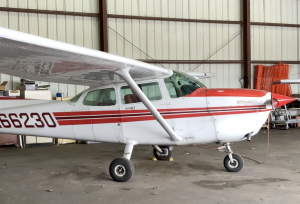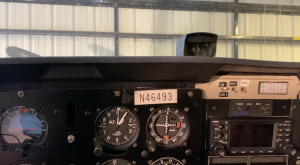For Ithaca resident Keegan Bakos, studying marketing and finance in college meant launching a career in the business world. That’s until he had a change of heart and the pandemic altered everything.
“So I basically came in here one day, I just walked in and asked about it. And I’ve been flying ever since then,” he said.
Bakos is referring to the East Hill Flying Club at the Ithaca-Tompkins International Airport. After signing up to fly he started experiencing the world from above, much different from an office desk. Now Bakos hopes to become a private or commercial jet pilot, and it all started with trying something new.
“I think if the pandemic hadn’t happened, I probably wouldn’t have had time to figure out what I actually wanted to do after school. So in a way, it was kind of a blessing,” Bakos said.

I recently visited the club and the members’ passion for flying is clearly evident, with instructors in the hangar inspecting the weather, members tending to their planes and the clear sight of a community brought together through flight.
Unfortunately, strong winds prevented me from getting in the air in one of the member’s planes. But at the East Hill Flying Club, they work around the windy days—and the snowy ones too. The club has over 200 hundred members with nine planes and a full in-house flight school.
“It’s 200 people who basically over the last 60 years have gathered, bought airplanes, manage them and have hired instructors to teach them and share in their management,” said Mark Sanford, a member and one the instructors at the club.
The club was officially founded in 1952 by employees of Robison Airlines, who wanted to learn to fly. From there, the club grew in many different facets, adding aircraft and members over the years.
Today, anyone can learn to fly. Club members range from local residents looking to try something new, young—high school aged aviators who get hooked on flying, and even Cornell or Ithaca College students looking to become private pilots.
The in-house school where students learn to fly is federally regulated and it’s serious business. “The FAA has given their stamp of approval,” Sanford said. “We do things in a very particular way. We keep very tight records and we have very high training and qualification standards for the instructors as well.”

For students like Bakos, the process can be long and challenging, but being thousands of feet in the air makes it all worth it.
“The world of aviation is actually really eye-opening once you get more into it,” Bakos said. “I had no idea about a lot of things—I thought planes just kind of did what they wanted.”
From the outside, aviation can be confusing, but the East Hill Flying Club allows pilots and new recruits to put in the work. “It has been a long and hard process,” Bakos said. But when I’m actually done, it’s something I’ll have for the rest of my life.”
As an instructor with thousands of hours of flight experience, that’s what Mark Sanford hopes to inspire in his students.
“You try to get them to understand the enthusiasm of flight,” he said. “In addition to just how cool it is that you can move an airplane from point A to point B at 150 miles an hour.”
Beyond the excitement, the flying club teaches the technical aspects that bring together concepts from a variety of disciplines.
“It involves, obviously, meteorology, medical factors of flight and it pushes you to learn more about those things,” Sanford said. “But it’s not just the science. There’s an art to it. You learn to balance, you learn thinking ahead and forethought—all those things combined.”

In a small city like Ithaca, the flying club creates a robust community of people with shared interests.
“It is an internal ecosystem, in of itself,” said Sanford. “We’ll have a lot of folks who would not normally mix who become peers or friends through the aviation community.”
The club welcomes anyone who is interested in signing up for classes and wants to get in the air, opening the door for kids and adults alike, who want to pursue a career in aviation.
“If you talk to a normal person around town, they have no idea what you’re talking about, with flying stuff,” said Bakos.
He found a place to learn and develop his career, adding, “coming here is cool because everyone here knows what the heck you’re talking about.”
The flight instructors, student pilots and general members all share their love for one passion—flying. From books on the table and aviator maps on the walls of the hangar, the enthusiasm for flight bonds the community together.
“My resume says, I ride around airplanes with people who aren’t pilots,” said Sanford. “That’s a pretty incredible thing, giving somebody the gift of flight, so it’s quite an honor.”











